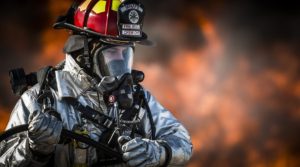Asbestos Exposure and Firefighters
 Firefighting: it’s among the world’s riskiest jobs. Firefighters’ health gets regularly jeopardized, without any idea of what they’ll encounter when they begin their shifts. They’re commonly called to residential fires, commercial complexes or industrial sites. All locations have individual hazards; however, the most typical material which threatens firefighter’s long-range health is asbestos. Fires of any level of severity may release asbestos into the air, and expose firefighters to toxic elements.
Firefighting: it’s among the world’s riskiest jobs. Firefighters’ health gets regularly jeopardized, without any idea of what they’ll encounter when they begin their shifts. They’re commonly called to residential fires, commercial complexes or industrial sites. All locations have individual hazards; however, the most typical material which threatens firefighter’s long-range health is asbestos. Fires of any level of severity may release asbestos into the air, and expose firefighters to toxic elements.
If you need emergency services insurance, call Steely & Smith Insurance at (215) 345-9410.
How Are Firefighters Exposed?
Firefighters get exposed to all materials used to build the structures they extinguish. Structures constructed before the 1980’s usually contain a broad array of asbestos-based building products. Those products are generally stable when left untouched; however, fire damage permits asbestos to become airborne in debris and smoke.
Firefighters may help fight the exposure with a SCBA (self-contained breathing apparatus) that has a HEPA (high-efficiency particulate air filter). Today, firefighters use that protective gear to avoid asbestos and other toxic material inhalation while on the job. However, in the past, the dangers of asbestos weren’t widely known.
Exposure to asbestos did not stop at the fire setting, as the ones contaminated with asbestos accidentally would transport the fibers back over to the firehouse. Asbestos also was utilized in several fire hall construction products, protective equipment, and fire truck parts.
Health Risk to Firefighters
For 30 to 40 years, some spend their careers in harmful situations, attending a multitude of fire settings, being exposed to asbestos for decades. Asbestos fibers are very harmful to anyone who is exposed to the airborne particles. Inhaled fibers may embed themselves into the abdominal linings or lungs and can’t be expelled once trapped in the tissues.
When fibers lodge themselves inside the body they eventually can trigger a fatal type of cancer referred to as mesothelioma. Oftentimes, ingested or inhaled asbestos doesn’t generate symptoms for years, and mesothelioma can develop anywhere from 20 – 50 years after exposure to asbestos. It’s important for firefighting operations to use proper precautions that safeguard their members’ health.
About Steely and Smith
At Steely and Smith we offer customized packages that best protect volunteer firefighters and firefighters.
Call Us Today at 215-345-9410 to go over your insurance needs and the special programs and services we can provide to your organization.
